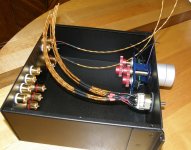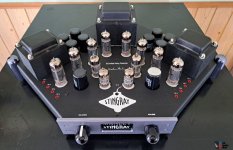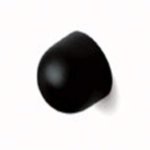So yes, now that I have gone in a little different direction, here the start of it. 4 inputs, 2 outputs, 2 mono 10k pots by Noble, and more heat shrink and wiring than I care to normally do. I have kept left and right signals on separate leads, and even the grounds will be separate by way of the selector switch. For the 2 outputs grounds are common to each other, and the signal lead from one output to the second output has a 150 ohm resistor. So far, so good. More connections to make tomm. and then test.
Attachments
I appreciate the information. I am hoping that because this switch is shorting, that might be avoided. All I need is another noise issue.
It was disappointing (it did vary with various amplifiers) so I swore never to switch GNDs again. The solution I found was not to switch analog inputs at all, switching digital inputs does not have these phenomena and doesn't need expensive switches. The money that is saved can be put into a good volume potentiometer.
A simplification of matters but with drawbacks 🙂
A simplification of matters but with drawbacks 🙂
Funny that you mention simplifying things. In the end, that is exactly what I intend to do. In fact, after the unit is tested, I will put it up for sale. Simple reason for this is that by a fluke, I found an old Manley Labs Stingray integrated amp for sale. As cool as it looks, the design was all about short signal paths, and the selector switch for each channel is on the back,,, well kind of. This is definitely not a boxy style amp. And the best part is that it uses a passive design for signal input.
Attachments
Less is more. The more I build the more I see simplicity is the key and less hardware/less mechanical stuff/less features/less choices is simply a joy. Contradictory with the desire to create, I know.
What comes with simplicity is using the devices for their intended purpose which is efficient.
What comes with simplicity is using the devices for their intended purpose which is efficient.
Man, I am envious of that! That is exactly the kind of thing that I would try this way and that, just to know what the outcome was! Did you ever get one built?@Ixnay
Interesting.
A few years back I "doodled" a dual mono preamp with each channel in a separate box on either side of a central section that held PSU regulators etc. plus differential 90 degree bevel gearing to drive the mono attenuators and switches.
View attachment 1169650
Today, I just ordered thick brass discs from Lee Valley. You can get different sizes and they make interesting visual pieces when placed behind a volume knob.
By the way, did the attenuations of the two Noble pots at very low levels, match adequately with this kind of assembly ?. . . 2 mono 10k pots by Noble . . .
PS
It's a long time since I diyed this kind of thing. Looking at it again, with you and Jean-Paul talking simplicity, I would now use only two geared pots, one facing towards the back, and a shaft extension with a single knob on the one facing forward. Pot assembly near the selector and the RCAs. The bigger the gears, space permitting, the further apart the pots would be.
Since the pots can be adjusted to mechanically gang together by flat spring tension, there is less worry about just that sort of thing. ANK products used to employ these Noble pots because of their quality until they were no longer made, making ANK build and design their own.
This mechanical apparatus can use extension rods and an extra set of gears resulting in the same action as you describe, but with only one split knob at the front of the unit.
Having said that, it was a conscious decision for me to buy the Manley Stingray just because the e selector knobs were close to the inputs, and also that each selector was a separate mono unit. I cannot say the same for the front panel volume and balance controls of the unit, except they are made by Noble. We'll see what I think when it arrives this week.
This mechanical apparatus can use extension rods and an extra set of gears resulting in the same action as you describe, but with only one split knob at the front of the unit.
Having said that, it was a conscious decision for me to buy the Manley Stingray just because the e selector knobs were close to the inputs, and also that each selector was a separate mono unit. I cannot say the same for the front panel volume and balance controls of the unit, except they are made by Noble. We'll see what I think when it arrives this week.
But. the maximum undistorted output voltage is only 2V5pp and would be far too low for a commercially available preamplifierIf you are satisfied with that power amp used as preamp at 12V supply voltage then I bet you don't measure anything?!
Yes a preamp with lower maximum output voltage than the sources nominal output voltages driving it makes itself redundant. It would also be a preatt and not a preamp.
Whilst its inventive and encouraging to see development in the mechanical aspects of using pots, keep in mind, it's not vastly different to the origins, such as the patent of 1919 for rheostats attributed to Mary Hallock Greenewalt , where she in a similar way attached pedals to activate her patent for rheostats, to play a visual display instrument she called "Nourathar" . https://patents.google.com/patent/US1357773A/en https://hsp.org/sites/default/files/legacy_files/migrated/findingaid0867greenewalt.pdf
There might be further ideas for you within Marys writing , which is available as a book
https://books.google.nl/books?id=l85kmX6rc50C&printsec=copyright&redir_esc=y#v=onepage&q&f=false
There might be further ideas for you within Marys writing , which is available as a book
https://books.google.nl/books?id=l85kmX6rc50C&printsec=copyright&redir_esc=y#v=onepage&q&f=false
I disagree, as it is just a matter of arranging sensitivity at a power amplifier to match or be close to line level standards. As example Quad the UK manufacturer providing since 1967 power amplifiers with sensitivity of 500mv, and refining further in 1986 with the 306 model at 0.375mv. If there is no change in voltage from source to power amplifier, other than the change caused by resistance to attenuate level, which should be, and can be negligible, , then distortion is much less. Simply because as there is yet, no voltage amplification that does not add distortion.Yes a preamp with lower maximum output voltage than the sources nominal output voltages driving it makes itself redundant. It would also be a preatt and not a preamp.
Last edited:
1967 and 1986 are both not 2023. We live in 2023. Sources today are 2Vrms (since a few decades with only a few exceptions) so we take 2Vrms as a standard.
The preamp as observed may 1st 2023 (today) is in reality a power amp with too low power supply voltage and as a result it produces a maximum of 2.5Vpp as a consequence so it has less headroom than its sources dictate. It will distort at 0.883 Vrms output voltage while the sources put out 2Vrms without any issue. At a certain volume level the preamp will start to distort while the power amplifier and the sources are not to blame. This has not much to do with good design/HiFi or correct system matching, it is a system choice or a deliberately introduced handicap.
It is in this case it is an effect generator, the inverse equivalent of the tube preamp with too high gain. A way to obtain less distortion according normal HiFi standards is to leave it out of the chain. A simple 10 kOhm logarithmic stereo potentiometer will perform better and it will save 2 caps per channel. It will also save energy wasted to heat for no clear benefit.
The preamp as observed may 1st 2023 (today) is in reality a power amp with too low power supply voltage and as a result it produces a maximum of 2.5Vpp as a consequence so it has less headroom than its sources dictate. It will distort at 0.883 Vrms output voltage while the sources put out 2Vrms without any issue. At a certain volume level the preamp will start to distort while the power amplifier and the sources are not to blame. This has not much to do with good design/HiFi or correct system matching, it is a system choice or a deliberately introduced handicap.
It is in this case it is an effect generator, the inverse equivalent of the tube preamp with too high gain. A way to obtain less distortion according normal HiFi standards is to leave it out of the chain. A simple 10 kOhm logarithmic stereo potentiometer will perform better and it will save 2 caps per channel. It will also save energy wasted to heat for no clear benefit.
Last edited:
But no, line level standards are not 2V , 2V is 0Dbfs which is the players maximum possible level without distortion. Quite different are line level standards which for consumer equipment, embedded in the medium being played to preserve dynamic content, is level confined to 0.310mv RMS https://en.wikipedia.org/wiki/Line_level The exception is CD Test Discs which will advise with massive warning when 2v is to be played.
Here is the Audio Engineering Society definition line-level Standard +4 dBu (pro) or -10 dBV (consumer) audio levels.
https://www.aes.org/par/l/#levels
Here is the Audio Engineering Society definition line-level Standard +4 dBu (pro) or -10 dBV (consumer) audio levels.
https://www.aes.org/par/l/#levels
Attachments
The used topology represent only a buffer (unity gain) and no gain stage - the great benefit is the no longer present unwanted low pass character dependent of the position of volume control in typical passive pre-amps. (What means the term "preatt" ?)Yes a preamp with lower maximum output voltage than the sources nominal output voltages driving it makes itself redundant. It would also be a preatt and not a preamp.
Since a long time usual line stages in line pre-amplifier are completely nonsense, because a gain factor of e. g. 10 (= 20db) produces an output voltage of 10Vpp max at 1Vpp input - too much for currently available power amplifier.
Nevertheless all commercial available pre-amplifiers I know show voltage amplification so as if all available power amplifiers had unity gain character (usual are here gain factors between 30-50).
But commercial unity gain power amplifiers I haven't found until this day.
I am lost in most of the technical discussion, and have no dog in the fight here.What means the term "preatt" ?
But I am fairly confident he meant to make a play on words.
If a Pre-Amplifier is called a preamp and increases the voltage.
Then would a device that reduces the voltage be a Pre-Attenuator? And thus could be called a preatt?
- Home
- Source & Line
- Analog Line Level
- passive preamp


